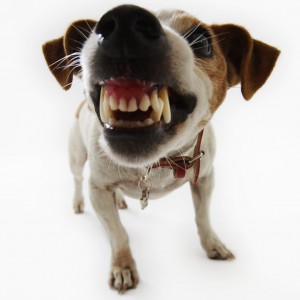All dog owners want to be able to enjoy their dogs. They also want them to behave and feel comfortable around people and other animals. Basic training when the pet is young will often help create a well-mannered dog, but sometimes problems do occur. Occasionally, a dog will show signs of aggressive behavior, and the owner will need to use dog training techniques to curb these actions before they get out of hand.
What causes it?
Aggressive behavior can come from many different sources. Some breeds have a tendency towards territorial or dominant aggressive behavior. In addition, a dog that is weaning pups or in pain may react aggressively towards other animals and people. If the pet is nervous or skittish, their fear may turn into hostility.
Before buying a dog, it is important to know what breed it is and any possible behavioral tendencies that breed may exhibit. More than just aggressive behavior, some breeds may be better with children, smarter or more prone to act hyper. Knowing about the dog will help in care, training and integrating the pet into the family.
Taking the dog to the family vet for a physical will help rule out any possible medical problems that could cause the negative behavior. Discuss any concerns about aggressive tendencies so that the vet can address those concerns. The root of the problem may be a simple one that is easy to correct.
Is there more than one type?
 There are different types of aggression, and each one exhibits its own symptoms. If the dog barks at other animals that are within eyesight, they may have a tendency towards territorial aggression. If the pet tries to boss around the kids and stare at you directly, then they may be dominant aggressive. Dogs that don’t let people go near their food or take something out of their mouth is a sign of possession aggression. Fear aggression is when animals growl and bite because they are afraid.
There are different types of aggression, and each one exhibits its own symptoms. If the dog barks at other animals that are within eyesight, they may have a tendency towards territorial aggression. If the pet tries to boss around the kids and stare at you directly, then they may be dominant aggressive. Dogs that don’t let people go near their food or take something out of their mouth is a sign of possession aggression. Fear aggression is when animals growl and bite because they are afraid.
Each of these types of aggression have different sources, and different dog training techniques will help break these bad habits before the dog harms someone.
How is it stopped?
Once research is completed on the breed of dog and the animal has been checked by a vet, it is time to start training the dog to break bad habits that are forming. Socializing with other dogs helps with most forms of aggression. Many people socialize their puppy when they first bring them home, but don’t continue this trend once the dog grows up. Introducing the pet to other animals should continue throughout its life, to help tone down aggressive tendencies.
Socializing should be done one on one, with both dogs on a leash and both owners present to separate them if there are any problems. If the aggressive dog starts to growl, the owner should reprimand the animal with a firm “no” and take them away from the other pet. Once the dog calms down, praise them and reintroduce the other animal. This technique keeps the dog from being over stimulated with too many strange animals, and prevents any possible fights or biting.
When walking the dog, take a different route each day so that territorial aggression is no longer an issue. Territorial aggression is exhibited when the dog determines another animal is in their territory, and their territory is set by them, not physical boundaries such as their yard or their block. So be alert to signs of aggressive behavior while on walks and at home. Reprimand the dog if they growl or act hostile, and then praise them when they have calmed down.
Possession aggression can be corrected by making the animal understand that their food bowls or toys are family property, not theirs. Setting these rules from the moment the dog arrives home will prevent possessive behavior. The owner should put their hands in the dog’s food bowl while they are eating and feed them bits of dog food by hand. Makes sure all family members do this as well so the dog understands that anyone is allowed in their bowl.
Dominant behavior is also best curbed from puppyhood. Have a set of firm rules that establish the pecking order in the household. Dogs live in packs, and every member of the pack has their place. Humans come in the hierarchy before dogs, even children. Do not let the dog get away with dominant behavior, and make sure that they listen to the children in the home as well as the adults. This will prevent hostile or bullying behaviors that are the symptoms of dominant aggression.
Ensuring the pet understands that the owner is alpha and the dog is omega does not mean that the human can’t show love or play with their pet. It simply means that the owner needs to be firm and expect good behavior from their dog. Parents don’t let children misbehave, the same goes with their pets. Dog training techniques for aggressive behavior are used to make sure the dog doesn’t bite anyone, a problem that can have many long term consequences.
